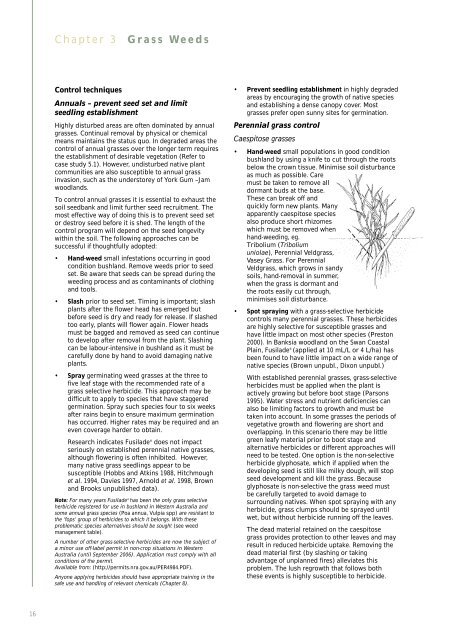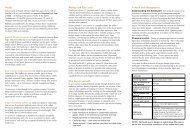Bushland Weeds Manual - Environmental Weeds Action Network
Bushland Weeds Manual - Environmental Weeds Action Network
Bushland Weeds Manual - Environmental Weeds Action Network
You also want an ePaper? Increase the reach of your titles
YUMPU automatically turns print PDFs into web optimized ePapers that Google loves.
16<br />
Chapter 3 Grass <strong>Weeds</strong><br />
Control techniques<br />
Annuals – prevent seed set and limit<br />
seedling establishment<br />
Highly disturbed areas are often dominated by annual<br />
grasses. Continual removal by physical or chemical<br />
means maintains the status quo. In degraded areas the<br />
control of annual grasses over the longer term requires<br />
the establishment of desirable vegetation (Refer to<br />
case study 5.1). However, undisturbed native plant<br />
communities are also susceptible to annual grass<br />
invasion, such as the understorey of York Gum –Jam<br />
woodlands.<br />
To control annual grasses it is essential to exhaust the<br />
soil seedbank and limit further seed recruitment. The<br />
most effective way of doing this is to prevent seed set<br />
or destroy seed before it is shed. The length of the<br />
control program will depend on the seed longevity<br />
within the soil. The following approaches can be<br />
successful if thoughtfully adopted:<br />
• Hand-weed small infestations occurring in good<br />
condition bushland. Remove weeds prior to seed<br />
set. Be aware that seeds can be spread during the<br />
weeding process and as contaminants of clothing<br />
and tools.<br />
• Slash prior to seed set. Timing is important; slash<br />
plants after the flower head has emerged but<br />
before seed is dry and ready for release. If slashed<br />
too early, plants will flower again. Flower heads<br />
must be bagged and removed as seed can continue<br />
to develop after removal from the plant. Slashing<br />
can be labour-intensive in bushland as it must be<br />
carefully done by hand to avoid damaging native<br />
plants.<br />
• Spray germinating weed grasses at the three to<br />
five leaf stage with the recommended rate of a<br />
grass selective herbicide. This approach may be<br />
difficult to apply to species that have staggered<br />
germination. Spray such species four to six weeks<br />
after rains begin to ensure maximum germination<br />
has occurred. Higher rates may be required and an<br />
even coverage harder to obtain.<br />
Research indicates Fusilade ® does not impact<br />
seriously on established perennial native grasses,<br />
although flowering is often inhibited. However,<br />
many native grass seedlings appear to be<br />
susceptible (Hobbs and Atkins 1988, Hitchmough<br />
et al. 1994, Davies 1997, Arnold et al. 1998, Brown<br />
and Brooks unpublished data).<br />
Note: For many years Fusilade ® has been the only grass selective<br />
herbicide registered for use in bushland in Western Australia and<br />
some annual grass species (Poa annua, Vulpia spp) are resistant to<br />
the ‘fops’ group of herbicides to which it belongs. With these<br />
problematic species alternatives should be sought (see weed<br />
management table).<br />
A number of other grass-selective herbicides are now the subject of<br />
a minor use off-label permit in non-crop situations in Western<br />
Australia (until September 2006). Application must comply with all<br />
conditions of the permit.<br />
Available from: (http://permits.nra.gov.au/PER4984.PDF).<br />
Anyone applying herbicides should have appropriate training in the<br />
safe use and handling of relevant chemicals (Chapter 8).<br />
• Prevent seedling establishment in highly degraded<br />
areas by encouraging the growth of native species<br />
and establishing a dense canopy cover. Most<br />
grasses prefer open sunny sites for germination.<br />
Perennial grass control<br />
Caespitose grasses<br />
• Hand-weed small populations in good condition<br />
bushland by using a knife to cut through the roots<br />
below the crown tissue. Minimise soil disturbance<br />
as much as possible. Care<br />
must be taken to remove all<br />
dormant buds at the base.<br />
These can break off and<br />
quickly form new plants. Many<br />
apparently caespitose species<br />
also produce short rhizomes<br />
which must be removed when<br />
hand-weeding, eg.<br />
Tribolium (Tribolium<br />
uniolae), Perennial Veldgrass,<br />
Vasey Grass. For Perennial<br />
Veldgrass, which grows in sandy<br />
soils, hand-removal in summer,<br />
when the grass is dormant and<br />
the roots easily cut through,<br />
minimises soil disturbance.<br />
• Spot spraying with a grass-selective herbicide<br />
controls many perennial grasses. These herbicides<br />
are highly selective for susceptible grasses and<br />
have little impact on most other species (Preston<br />
2000). In Banksia woodland on the Swan Coastal<br />
Plain, Fusilade ® (applied at 10 mL/L or 4 L/ha) has<br />
been found to have little impact on a wide range of<br />
native species (Brown unpubl., Dixon unpubl.)<br />
With established perennial grasses, grass-selective<br />
herbicides must be applied when the plant is<br />
actively growing but before boot stage (Parsons<br />
1995). Water stress and nutrient deficiencies can<br />
also be limiting factors to growth and must be<br />
taken into account. In some grasses the periods of<br />
vegetative growth and flowering are short and<br />
overlapping. In this scenario there may be little<br />
green leafy material prior to boot stage and<br />
alternative herbicides or different approaches will<br />
need to be tested. One option is the non-selective<br />
herbicide glyphosate, which if applied when the<br />
developing seed is still like milky dough, will stop<br />
seed development and kill the grass. Because<br />
glyphosate is non-selective the grass weed must<br />
be carefully targeted to avoid damage to<br />
surrounding natives. When spot spraying with any<br />
herbicide, grass clumps should be sprayed until<br />
wet, but without herbicide running off the leaves.<br />
The dead material retained on the caespitose<br />
grass provides protection to other leaves and may<br />
result in reduced herbicide uptake. Removing the<br />
dead material first (by slashing or taking<br />
advantage of unplanned fires) alleviates this<br />
problem. The lush regrowth that follows both<br />
these events is highly susceptible to herbicide.



